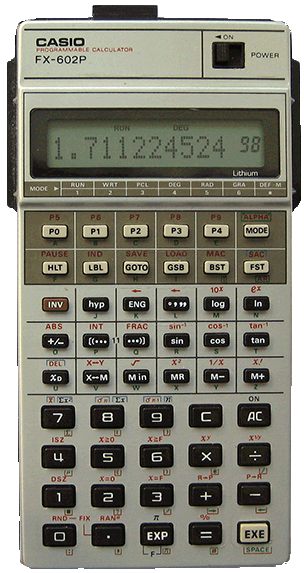casio fx-602p
| the fx-602p released around 1982 is thought by
many as the finest calculator casio ever made. An evolution
of the fx-502p with more memory and
an alpha-numeric display. it was the last of the casio step
programmables and alpha was added to compete with the hp41c. hereafter, casio moved onto
basic programmable pocket
computers like the fx-700p,
although for a time, this model was concurrent with the fx-702p which wasn't sure whether it
was a pocket computer or a calculator.
the 10+2 display also accommodates 11 alpha characters consisting of upper and lower case letters together with many useful symbols. the display is clear for a dot matrix type. there is no external contrast control, but the display contrast could be adjusted with a potentiometer after opening the unit. the unit is programmable with constant memory, totalling of 512 steps and 22 memories (M00-M19 plus MF and M1F). this number can be partitioned, trading in steps for more memories. between 22 and 80 memories are allowed corresponding to between 512 and 32 steps. the base memories cannot be converted into more steps than 512. When you altered the memory partition to gain more memory registers (at the cost of 8 program steps for each memory register), you always got an extra F Register for every 10 Memory registers. If you had M20-M29, you also got M2F as a bonus. Where this extra memory space came from, I don't know. programmability is the same as the fx-502p with a comprehensive set of instructions including 4 tests, isz & dsz (increment/decrement and jump if zero) for compact loops, labels, subroutines and indirect addressing. The original F Register (located at the EXP key) was used for number comparisons. There were 4 kinds of comparison: x=0, x?0, x=F and x?F. Although the F register played an important role, there was nothing special about the other F Registers. Some people tuned their FXs by overclocking the chip. The calculator went incredibly fast. Sad to say, this was also the end of making music with this calculator. writing and debugging program is a lot easier thanks to the alpha ability. of course, text can be used within programs to prompt the user for input and to augment output. however, the unit does not have any kind of programmable string variables or string manipulation. there are 10 program slots and a program can be password protected. this means it cannot be viewed or modified unless the password is entered. perhaps this was intended for commercial program libraries or simply to prevent someone else wrecking your programs by accident. Password protection was a fine feature but it didn't prevent the programs from being completely cleared with [MODE][3][INV][MAC]. the keyboard functions include the usual scientific functions, hyperbolic, 11 levels of brackets, 1-d statistics, but fractions are missing. operation is algebraic entry, and it is rather strange to use a alpha-numeric calculator that is not formula entry. here, you press 5 then tan rather than press tan then 5 like most do today. the unit is powered by 2 cr2032 lithium cells. this is a step up over the older 502p, so it must require more power; possibly for the display. the 602p obviously did not require the programming keyboard overlay of the fx-501/502p which decoded the program codes into keys, but it did have the music overlay which enabled sound to be played through the FA-1 cassette adapter (just like the 502p). The coding was the same as for the fx-501p. The Memory keys (Min, MR, M+, M- and x-M) gave the length of the tone whereas the number in the respective Memory register represented the note. The value in the F Register determined the tempo. They even thought of ties and breaks to make more sophisticated rhythms possible! the 602p does not handle dotted notes the same way as the 502p. On the 602p you have to tie a note to another note using "-", for example a half-note "-" quarter-note. Since the higher notes were slightly louder, you could even use this unit as a sequencer for voltage controlled analog sythesizers. You can hear one of these calculator models in the song "Pocket Calculator" on the album "Computer World" by KRAFTWERK. Apparently, the password protection could be cracked the following way : loop: during the run-loop you could press HTL, and then EXE, HLT in small delays would because of a bug in the firmware display the contents of the memory step by step and also the password would be visible ( filed reverse unencrypted ) and could be seen in the display. Credits:
|
 |